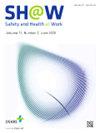Nonauditory Impacts of Industrial Noise Exposures: A Case Study From a Steel Manufacturing Industry
IF 2.9
3区 医学
Q1 PUBLIC, ENVIRONMENTAL & OCCUPATIONAL HEALTH
引用次数: 0
Abstract
Background
Excessive workplace noise poses a significant threat to occupational health, impacting both auditory and nonauditory health. This research examined the nonauditory effects of noise on steel workers.
Methods
A cross-sectional study of 80 industrial workers exposed to occupational noise was conducted with approval from the institutional ethics board and management. Nonauditory impacts such as fatigue, headache, vertigo, sleeplessness, and fainting were assessed. Noise levels were measured using an American National Standards Institute sound-level meter, and blood pressure (BP) and heart rate (HR) were recorded before and after shift. Data were analyzed using SPSS (version 20).
Results
The study revealed that 57% of workers experienced noise exposure exceeding the American Conference of Governmental Industrial Hygienists threshold limit values, with an average exposure of 88.5 dBA (range: 80.2–96.9 dBA). High-noise exposure was linked to fatigue (54%) and chronic headaches (5%). Preshift and postshift HRs were 82 ± 9 and 92 ± 13 bpm, respectively, while systolic and diastolic BPs averaged 135 ± 17 and 90 ± 11 mmHg, respectively. Significant cross-shift HR differences were observed in the blooming mill (p = 0.002) and bar and roll mill (BRM) (p = 0.010). Noise levels were significantly associated with systolic (p = 0.002) and diastolic (p = 0.001) BP in the bar and roll mill.
Conclusion
High occupational noise exposure may have adverse physiological effects. Despite existing regulations, enforcement and compliance remain inadequate. Implementing engineering controls, hearing conservation programs, and stringent policies is crucial to protect workers in high-noise industries.
工业噪音暴露的非听觉影响:来自钢铁制造业的案例研究
工作场所过度噪声对职业健康构成重大威胁,对听觉和非听觉健康都有影响。本研究考察了噪音对钢铁工人的非听觉影响。方法经单位伦理委员会和管理层批准,对80名工业工人进行了职业性噪声暴露的横断面研究。评估非听觉影响,如疲劳、头痛、眩晕、失眠和昏厥。使用美国国家标准协会的声级计测量噪声水平,并记录轮班前后的血压(BP)和心率(HR)。数据分析采用SPSS (version 20)软件。结果57%的工人的噪声暴露超过了美国政府工业卫生学家会议的阈值,平均暴露为88.5 dBA(范围:80.2-96.9 dBA)。高噪音暴露与疲劳(54%)和慢性头痛(5%)有关。换班前和换班后的hr分别为82±9和92±13 bpm,收缩期和舒张期平均血压分别为135±17和90±11 mmHg。在花式轧机(p = 0.002)和棒辊轧机(p = 0.010)中观察到显著的交叉移位HR差异(p = 0.002)。噪音水平与棒材轧机的收缩压(p = 0.002)和舒张压(p = 0.001)显著相关。结论职业性高噪声暴露可能对人体产生不良的生理影响。尽管有现行规章,但执行和遵守仍然不足。实施工程控制、听力保护计划和严格的政策对保护高噪音行业的工人至关重要。
本文章由计算机程序翻译,如有差异,请以英文原文为准。
求助全文
约1分钟内获得全文
求助全文
来源期刊

Safety and Health at Work
Social Sciences-Safety Research
CiteScore
6.40
自引率
5.70%
发文量
1080
审稿时长
38 days
期刊介绍:
Safety and Health at Work (SH@W) is an international, peer-reviewed, interdisciplinary journal published quarterly in English beginning in 2010. The journal is aimed at providing grounds for the exchange of ideas and data developed through research experience in the broad field of occupational health and safety. Articles may deal with scientific research to improve workers'' health and safety by eliminating occupational accidents and diseases, pursuing a better working life, and creating a safe and comfortable working environment. The journal focuses primarily on original articles across the whole scope of occupational health and safety, but also welcomes up-to-date review papers and short communications and commentaries on urgent issues and case studies on unique epidemiological survey, methods of accident investigation, and analysis. High priority will be given to articles on occupational epidemiology, medicine, hygiene, toxicology, nursing and health services, work safety, ergonomics, work organization, engineering of safety (mechanical, electrical, chemical, and construction), safety management and policy, and studies related to economic evaluation and its social policy and organizational aspects. Its abbreviated title is Saf Health Work.
 求助内容:
求助内容: 应助结果提醒方式:
应助结果提醒方式:


